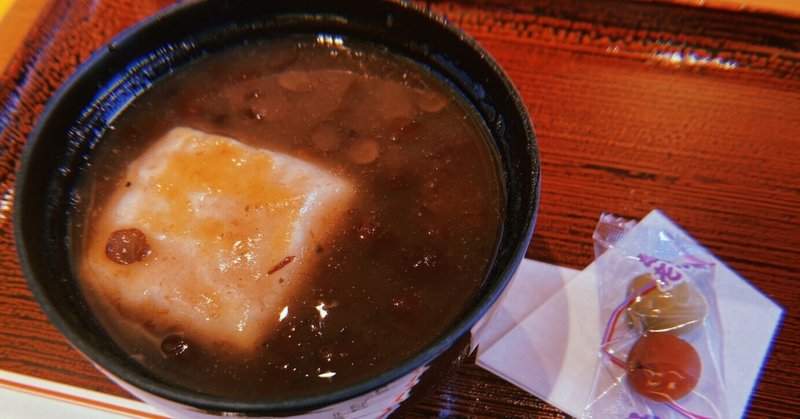
Dig Japan vol.1 “Shiruko (しるこ) and Zenzai (善哉)”
Both shiruko (しるこ) and zenzai (善哉, ぜんざい) are wagashi, Japanese traditional sweets, made with azuki beans and mochi, and because of their similar appearance, they are often confused. In fact, the names differ depending on the region, Kanto or Kansai, and this can be explained with shiruko's recipe. Shiruko, also known as oshiruko, is made by adding water to azuki bean paste, boiling it, and then adding toasted mochi, dango, or candied chestnuts. In the Kanto region, there is no distinction between koshian (strained bean paste) and tsubuan (grained bean paste), and both are called shiruko, and bean paste without soupiness itself is called zenzai. In the Kansai region, on the other hand, one made with koshian called shiruko, and one made with tsubuan called zenzai. In addition to their appearance, are their origins similar?
Shiruko

Let's start with shiruko. Its origin can be found as “Susuridango (すすりだんご)” in the latter section of “Ryori Monogatari (料理物語)” published in 1635 during the Edo period. This was a type of soup with dango made from 60% of glutinous rice and 40% of non-glutinous rice, simmered in azuki bean powder soup, seasoned with salt, and topped with white sugar. Initially, shiruko was not sweet, but rather salty, and was sometimes used as a side dish. Modern shiruko is sweeter, and there are also versions with regional colors such as “Meoto Zenzai (夫婦善哉)” in Osaka and “Zunda Shiruko (ずんだしるこ)” in Sendai. At Japanese tea houses, in particular, shiruko is often served with shiokombu (kelp cooked in brine and soy sauce) or Japanese pickle to refresh the palate or enhance the sweetness. Susuridango still exists in Oita Prefecture and other places, and sometimes refers to soup made with corn dumplings, or to dishes such as suiton, which is made by boiling dango with vegetables.
Zenzai
So, that is shiruko's origin, but now let's move on to zenzai. There are two main theories of its origin: one theory is that it originated from the Buddhist term “zenzai (善哉),” and the other is originates from “Jinzai Mochi (神在餅)” of the Izumo region, Shimane Prefecture. As for the former theory, Ikkyu Sojun (一休宗純) allegedly was the first to eat it, and the name came from the fact that he exclaimed that word because of its good taste. Zenzai is a word used by the Buddha to praise his disciples, and is a Chinese translation of “sadhu” meaning ‘great’ in Sanskrit. Regarding the latter theory, Jinzai-mochi was served at the Jinzai Festival (神在祭) which is a Shinto ritual in the Izumo region, and it is said that the word “jinzai” was accented and changed to zenzai. The Matsue clan's topographical book “Unyoshi (雲陽誌)” (1717) stated the origin of zenzai was the Izumo region. Zenzai became a familiar wagashi that spread throughout Japan with regional variations. In Japan, we eat zoni (雑煮) on New Year's Day, but in the Izumo region, zenzai is more common.
This article was written by 𝐡𝐢𝐫𝐨𝐤𝐨, working as a freelance translator and press for overseas apparel brands in Japan, with the purpose of broadening her insight into the Japanese traditional culture.
いつも読んでくださってありがとうございます☺︎いただいたサポートは、記事のクオリティ向上に活用させていただきます。応援よろしくお願いします❦
